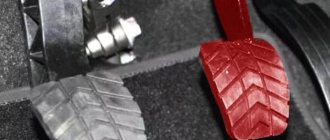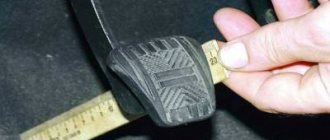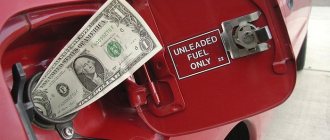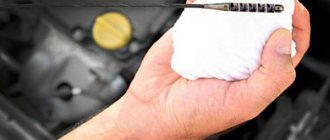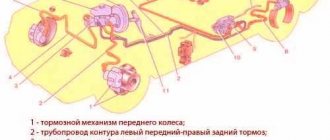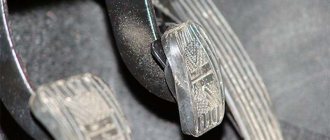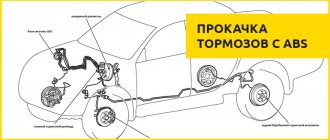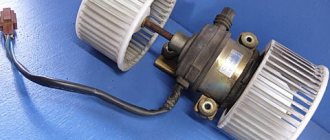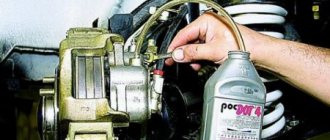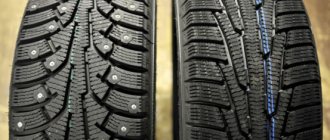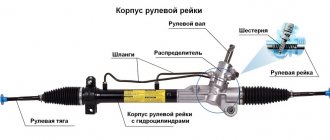Why the brake pedal fails: we find out the reasons and troubleshoot problems
Issues discussed in the material:
What is the general principle of operation of the brake system of a car
? What are the main reasons that the brake pedal fails?
Why does the brake pedal fail after bleeding and with the engine running?
A properly functioning braking system is an important element of safety and even a guarantee of the life of the driver and other road users. If your car's brake pedal fails, this is a danger signal. This means that you need to check the entire brake system and find out why the brake pedal is falling down.
The liquid turned into soda
The working fluid of brake hydraulics is capable of transmitting force only if it retains its incompressibility. Liquids and solids have this property, but not gases. The appearance of any of them inside the system ensures its failure. The reasons why the brake pedal fails can be different.
- The system seals are made of a material that blocks the path of both liquids and gases. But at a certain stage of their aging, a stage is possible when they still hold liquid with difficulty, but air begins to pass almost unhindered . As a result, during any braking, the moving parts are likened to a pump, pumping outside air into the hydraulic area. It accumulates and partially dissolves in the liquid. The incompressibility of the working fluid disappears, the stroke of the working cylinder rod increases.
- In addition to the external penetration of parasitic gas, it can also form from the liquid itself. It has the property of hygroscopicity, that is, it is capable of dissolving water vapor from the atmosphere well. The boiling point of water is significantly lower than that of the original composition, which engineers specially worked on, increasing its temperature threshold. The resulting water vapor is a gas, so the phenomena already described above occur. Moreover, this will happen at a critical moment, when the brakes work intensively, which is accompanied by heating.
- More prosaic reasons for airing the brakes are also possible. These are errors in their repair and poor pumping. This is what will appear the first time you try to brake urgently.
Treatment of the situation comes down to following basic brake care rules. The fluid must be changed on time, as specified in the instructions for the car, and not use cheap substitutes. Inexperienced personnel who have little understanding of the technological process should not be allowed to repair brakes.
Why does the brake pedal fail?
One of the elements of the described hydraulic system is a special composition circulating through tubes and other cavities. The main feature of brake fluid is that it cannot be compressed. As a result, the force from pressing the pedal is transferred “unchanged” to the pads, which stop the rotation of the wheel. “Sinking” indicates that the line has become larger in volume or has depressurized. The main causes of the problem are discussed below.
The technical condition of the car, including its braking system, can be checked using a car diagnostic scanner. A similar device costs around 2,000 rubles, which will pay for itself in 1-2 trips to the service station. Of those on the market, we can recommend Scan Tool Pro Black Edition
This car scanner is compatible with most old and new cars, easy to use and has wide functionality. The advantages of this model include not only engine diagnostics, but also other vehicle systems. Connection is made using bluetooth or wi-fi. All information about the condition of your car and a description of existing faults is displayed on the screen of your phone or tablet in Russian.
Low quality brake fluid
The composition circulating in the system is quite aggressive. Gradually, bad brake fluid begins to corrode rubber and even metal parts, hoses, and tubes through which it moves. The walls of the latter become thinner to such an extent that they swell when pressure is created. Because of this:
- an excess volume is created into which the brake fluid goes;
- when you add it, the pressure is restored, but the tubes may not be able to withstand it: microcracks form through which the liquid gradually leaves and air enters instead (when the pedal moves in the opposite direction, it is literally sucked in). In the worst situation, the hoses may burst.
Air in the brake system
Its entry into the line is a consequence of depressurization of components and parts of the brake system. A plug may also form due to the fact that the fluid level in the tank has dropped below the existing MIN mark. Another reason is improper bleeding of the brakes when replacing the circulating compound. The danger with air in the system is that, unlike liquid, it is compressed. As a result, the force applied to the pedal goes to waste - in the literal sense of the word.
Master cylinder malfunction
Its main problem is most often related to depressurization. This occurs due to deformation and rupture of seals - cuffs. Their destruction is caused by poor-quality brake fluid or natural aging of the elements. The main brake cylinder becomes leaky even if scratches or wear appear on its walls.
This occurs due to the appearance of foreign particles in the line. They can get inside if the system is carelessly and inaccurately filled. Sometimes “extra” elements are wear and tear products if the car has been in use for a long time.
Repairing a brake cylinder is a difficult task. If you do not have the relevant experience and do not have special tools or devices, it is better to take the part to a workshop or buy a new one.
Problems with the vacuum booster
If it is faulty, then most often this can be determined by the characteristic hissing sound that occurs when you press the brake pedal. This situation may indicate depressurization of the vacuum pump. The reason may lie in a ruptured diaphragm, seals, or a broken equalizing valve. To solve the problem, purchase a repair kit and replace all rubber parts. Air can also enter the vacuum booster due to cracks in the underwater pipes: tighten the clamps on them or, if damaged, replace them (in a carburetor car, such a hose fits at the bottom of it).
Incorrect clearances
We are talking about the presence of a gap between the main brake cylinder (its rod) and the pedal. The latter in this case fails and remains in this position. If the clearance is correct, the pedal will initially move smoothly, but at a certain period of travel it will become stiff. If the distance to the GTZ rod is large, resistance to pressing will be felt only at the very end of the stroke.
Unprofessional repair
The reason when the brake pedal fails may lie in the caliper, the fastenings of which are not tightened well enough. Then its vertical axis will be shifted in relation to the brake disc and the pads will not be able to get used to function properly. Also, any unprofessional actions (poor tightening, lack of spring washers where needed, etc.) when repairing or bleeding the brake system will lead to its ineffective operation.
Corrosion
The metal that makes up some of the brake system elements can simply rust. In such cases, the pedal goes down and freezes there, from where it has to be “picked out” with a pry bar or other improvised tool. Corrosion usually succumbs to traction, which just needs to be sanded off.
Brake pad wear
In this situation, an increased gap appears between the disc and the pads. As a result, the pressure created in the system is not enough to brake the wheel. The solution is obvious: replacing the pads.
When not to panic
- If you got behind the wheel, decided to start the engine after a long period of inactivity, pressed the brake and started the engine, and at that moment the pedal “went away,” then there is no need to look for a malfunction: the phenomenon is normal. The fact is that when the car starts, the hydraulic vacuum booster begins to work: the process involves installing the mechanisms of the unit into the working position. It’s just that there is a difference between the force transmitted to the pedal when the engine is turned off and when the engine is running.
- If the brake fails after completing repair work to replace the pads, it also does not always indicate problems. In this case, the pedal begins to “go away” after bleeding the system, but then functions normally. This is due to the pistons of the working brake cylinders - they “search” for some time for the optimal gap between the disc and the pads.
The brakes on the VAZ 2107 are gone, the pedal falls through
The vehicle must always be maintained in perfect working order. One of the main elements of a vehicle is the braking system. The functioning of the entire vehicle and the safety of the driver depend on its proper condition. That is why, at the first signs of a malfunctioning brake pedal or its failure, it is necessary to contact specialist auto mechanics.
Main causes of malfunction
Before starting repairs, the cause of the failure should be determined. It could be:
- Malfunction of the main brake cylinder;
- Unadjusted gap between the pedal and the cylinder piston;
- Poor quality brake fluid or insufficient brake fluid;
- Incorrectly installed brake disc or pads;
- Faulty vacuum pump.
It is critical to quickly determine what is causing your brake pedal to fail. The breakdown proceeds smoothly, sometimes even unnoticed. When you press the pedal, it starts to press very lightly to the floor.
How to diagnose a problem if the brake pedal fails
In order to diagnose the brake pedal for damage, it is necessary to carry out a number of measures. It is recommended to do this at a service station, by the hands of experienced specialists. It can cost up to 5 hours of time and a round sum. However, if financial capabilities do not allow you to go to the service, then, if desired, any car owner can solve the problem on their own:
- Lack of brake fluid. You just need to check for its presence and top up if necessary;
- Checking the brake pedal.
- Checking pads and discs. Pedal failure can occur due to insufficient pressure on them;
- Checking the brake cylinder;
- Checking the integrity of the pumps.
How to install HBO and register with the traffic police and how to avoid unnecessary troubles - see here.
Finding out why the brake fails
Most often, the pedal fails due to the fact that the brake system is serviced with low-quality brake fluid. This fluid can cause the brake lines to swell and begin to disintegrate. In order to check if there is a problem with them, you need to blow out the brake pipes. For comparison, you need to take a new tube and blow it out in the same way to understand how badly the car’s brake hose is clogged.
An air lock in the brake system can also cause pedal failure. The air that gets into the brake pipes begins to compress. This happens due to wear on the lines or improper replacement of the brake fluid. Pressing the brake pedal does not perform the braking process, but compresses the air. In this case, the pads are practically motionless. Braking is ineffective or completely absent.
Problems with the master brake cylinder (pictured). Its rubber seals may swell and delaminate. This usually occurs when using low quality brake fluid and due to tire wear. All this leads to the fact that the system is susceptible to depressurization and leakage of liquid. This problem can be solved by replacing the rubber seals. After this, you need to bleed the system to eliminate air congestion. Replacing the master brake cylinder will be necessary in case of excessive wear on the working surfaces.
Vacuum booster - symptoms of malfunction
Almost all cars have a vacuum booster. It reduces the force applied by the driver to the pedal, while at the same time increasing the force transmitted by the fluid. It only works after the engine is started. Poor performance is often caused by wear or damage to the vacuum seal diaphragm. In this case, no vacuum is created in the chamber. We need to look at the fuel fluid level: if it is normal, we check the operation of the amplifier. If the vacuum tank is not topped up in a timely manner, it first malfunctions, then the diaphragm is damaged.
First, we check with the engine not running: depress the pedal and hold it pressed. If it begins to gradually fail, the reason is in the gas turbine engine: the cuffs are leaking or the working surface of the cylinder is worn out. Without releasing the pedal, we start the engine. It should fall smoothly and slightly and stop. If everything is exactly like this, then the vacuum seal is in order. If the pedal falls while the engine is running, the reason is in the amplifier, the GTZ is to blame. When driving with a damaged diaphragm, the speed during braking practically does not decrease. You need to immediately replace the diaphragm with a new one.
When the vacuum seal dies, when braking, the car, especially in cold weather, tends to stall, and the noise of escaping air is clearly audible.
Are adjustments done differently on different brands of cars?
The above procedures are universal and can be performed on machines from any manufacturer. The essence of the procedure is always the same - to reduce or increase the pedal stroke by tensioning or loosening the cable, or adjusting the hydraulic pusher.
But when adjusting the clutch in cars of different brands, there may be some differences. For example:
- normal pedal amplitude or clutch clearance;
- procedure for accessing the clutch adjusting and control nuts. So, in a VAZ-2114, 2115 you will have to remove the battery before starting work, and in a Lada Kalina you will have to unscrew the air filter.
Before starting work on adjusting the clutch, read the technical information about your vehicle, the operating instructions and the repair manual. This will allow you to complete the procedure correctly.
VAZ 2115 Bleeding the brake system
After each brake repair, during which the system was opened, air may appear in the pipelines. In this case, the system should be bled. There is air in the system if the pressure fluctuates when you press the brake pedal. In this case, the leak must be repaired and the brake system must be bled.
Air is removed from the brake system by pumping the brake pedal; this requires the help of an assistant. If you need to bleed the entire system, you should bleed each cylinder separately. This is the case when air has entered each cylinder. Bleeding sequence: 1 - rear right wheel cylinder, 2 - rear left wheel cylinder, 3 - front right brake caliper, 4 - front left brake caliper.
If only one caliper has been replaced or repaired, it is usually sufficient to bleed only that caliper.
Before bleeding, unscrew the cap of the compensation tank and fill it with brake fluid to the maximum mark.
While pumping, monitor the fluid level in the tank. The fluid level should not drop too low, otherwise air will enter through the reservoir. Always top up with fresh brake fluid. Only brake system with ABS: Turn on the ignition and depress the brake pedal 4 - 5 times. Then, if necessary, add brake fluid to the reservoir to the maximum level. When bleeding the rear brakes, leave the ignition on during the entire bleeding. When the bleeder valve opens, the ABS hydraulic pump will turn on and create pressure.
Should I be concerned if the brake pedal is stiff or soft after bleeding?
The manufacturer has ensured that the brake pedal is pressed as easily and conveniently as possible. It is important that there is no need to exert significant effort while pressing, and various dips and jerks are unacceptable. Regardless of whether the brake pedal is soft and does not stop well, or there is a problem of some other kind, it is important not to leave things to chance. In general, if the brake pedal fails, then you urgently need to go to a service station or top up the brake fluid yourself. Most likely there is a leak in the brake system.
Both a tight pedal and too easy its movement are an alarming symptom that can indicate a number of serious problems.
Master cylinder malfunction
If there is no brake fluid leak, a symptom indicating the possibility of a breakdown of the GTZ unit is that the pedal slowly stops working, while holding it down, only after the second or third stroke can it stand firmly. Failure of the master cylinder is the result of wear of the piston sealing elements and the inability to maintain high pressure in the hydraulic system for effective operation of the brake mechanisms. Thus, the liquid returns back to the reservoir. The problem is solved by replacing the device or restoring it with a repair kit.
Why is the pedal soft?
Due to certain problems, the brake pedal frog may also be faulty. Such a nuisance can come “in full” along with other related ones. Very often, a soft brake pedal is the direct cause of a significant deterioration in vehicle control.
A soft brake pedal may be a simple feature of the model. The cause of malfunctions may be air entering the relevant system. Everything is corrected by bleeding the brake itself in order to protect it from possible problems.
In turn, air can enter the system in many ways, and if problems appear with it, then most likely it is to blame. The pipeline may well lose its seal or even burst in this case. Due to a breakdown of the master cylinder, in which the brake fluid begins to boil, corresponding problems also arise. An accompanying failure is often jamming of the piston. It is advisable to diagnose the cylinders and check the brake fluid. It would also be a good idea to do a complete health check of the machine to determine if there are any hidden problems, if any.
